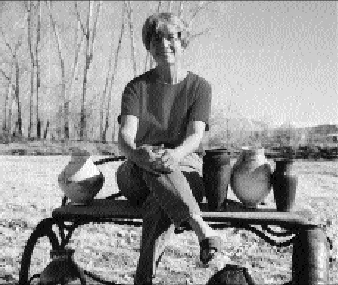Ancient Art
by Carol McDermott
 Montrose, Colorado On a typical western Colorado farm, not far from the Uncompahgre River, the ancient Japanese art of raku is practiced by a most modern American woman. The farmhouse has a new red roof, and the kiln is fired with gas, but the art is deeply rooted in Japa se tradition. Nita Lightsey said that working with raku is “always like Christmas morning,” because of the surprises its firing brings. Raku, loosely translated, means enjoyment, pleasure,
Montrose, Colorado On a typical western Colorado farm, not far from the Uncompahgre River, the ancient Japanese art of raku is practiced by a most modern American woman. The farmhouse has a new red roof, and the kiln is fired with gas, but the art is deeply rooted in Japa se tradition. Nita Lightsey said that working with raku is “always like Christmas morning,” because of the surprises its firing brings. Raku, loosely translated, means enjoyment, pleasure,
comfort, happiness or contentment. It is a process in which clay pieces are placed in a pre-heated kiln, then brought up to temperature quickly. When the glaze has matured, the pieces are removed from the kiln, and either cooled quickly in water, slowly in the open air, or placed in a barrel of combustible material, covered, and smoked for a time. Nita puts her pottery in trash cans filled with shredded newspaper, then covers them tightly. The hot pieces ignite the paper, generating smoke. Colors are produced because of oxygen starvation.
After about 40 minutes, Nita removes the pieces and cleans the remaining residue. The result is a fragile, beautiful piece of decorative art. Nita was reared on a ranch north of Genoa, Colo. “I grew up wanting an art teacher, wishing for an art teacher.” She “did” the art for her school, but was not formally taught an art curriculum until the mid-1970s when she attended Western State College in Gunnison. She had moved to Montrose, Colo., in 1966, with her husband, Travis, who was a junior high science teacher. Nita served as an elementary school secretary for a while. She began teaching high school art in 1975. Her principal suggested she offer a pottery program. “I had to learn. I had to bring my skills up to shape. I asked Pat Julio, my WSC mentor, how to accomplish this, and he said ‘Practice.’ So that’s what I did.” For over 20 years Montrose High School students filled her classes. Many of her students went in to careers in ceramics, as professional artisans and as teachers.
“Art is an emotional response to life. People turn to art in their time of need,” she said. Although she has stopped doing shows, Nita has not stopped doing art. Despite fibromyalgia, pain in the soft tissues which she controls through diet, Nita continues to “break the rules in firing porcelain in raku.” This fragile art form used in ancient Japanese tea ceremonies was discovered by the Western World in 1911. It has been modified by its practitioners, who altered it to suit themselves, throughout the 20th century. Yet it remains unaffected in Japan, where the fifteenth generation of the Raku Family continues to produce its traditional raku tea ware. Nita’s raku, and Nita, herself, can be seen at the Ouray Gallery. She may be contacted at [email protected].
